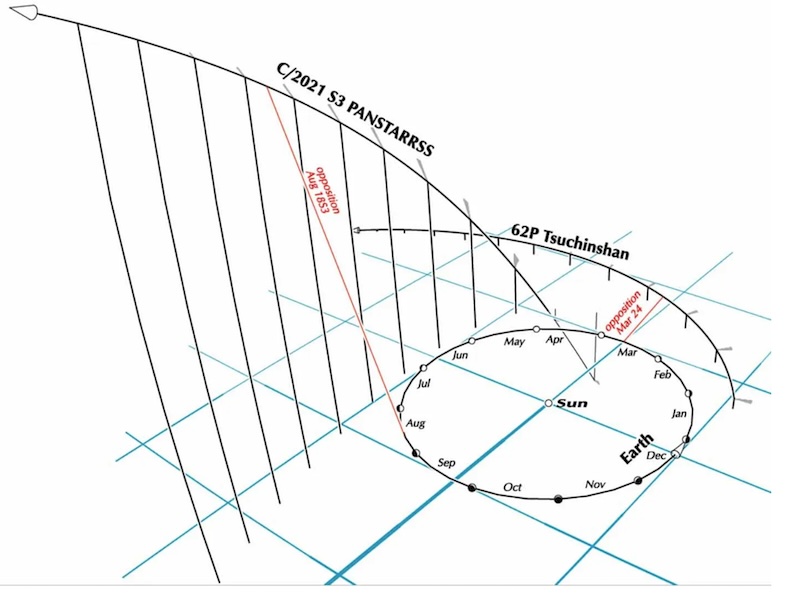
Observable comets in 2024
UK astronomer Guy Ottewell published his article about comets in 2024 at his website on January 12, 2024. Reprinted with permission. Edits by EarthSky.
2024 lunar calendars on sale now. Makes a great gift! Check it out here.
Comets are always unpredictable
The predicted brightness of a comet – an icy visitor, often from the outermost reaches of our solar system – can and does change frequently. For example, a comet’s orbital elements can change, as observations are continually sent in by observers around the world. Or, a comet’s brightness parameters may be changed. The brightness predictions are based on a comet body’s size (typically around six miles, or 10 km, in diameter) and the rate at which it brightens by shedding cloudy material as it approaches the sun.
Also, new comets can and do appear from the depths of space.
So comets don’t always behave as we think they will! That said, my calculations suggest the comets in the chart below will be brighter than 9th magnitude in 2024. That is, they’ll be bright enough to observe with binoculars or small telescopes in dark sky.

More about this chart
Just so you know … the above list of observable comets – and their brightnesses or magnitudes – can change at any time.
See the note at the bottom of this post to learn how I calculated 2024’s observable comets. After disentangling my calculations, I find these comets might be brighter than magnitude 9.5 in 2024. In other words, these are the comets you might see with ordinary 7X50 binoculars. And, if we’re lucky, some of these comets could become visible to the eye alone.
By the way, the 9.5 magnitude threshold is arbitrary. Changing it admits more or fewer comets. Also, there is always the caution that their actual behavior can depart wildly from what’s predicted. That’s because comets can flare, or shed so much of their cloudy material that they become like asteroids. Or comets can break into several bodies, and completely disintegrate and disappear. Never bet on a comet! Additionally, there are often new comets of the non-periodic kind, which are unpredictable and are liable to be among the brightest. These can arrive from deep space at any time.
Comet 62P Tsuchinsha
62P Tsuchinsha’s designation means that it was the 62nd comet to be recognized as periodic – that is – with elliptical orbit of under 200 years. And it was at its brightest for 2024 on January 1, 2024. That’s because it passed its peak brightness on December 25, 2023. However, reports are that it may be running about one magnitude brighter than predicted and is currently shining around magnitude nine.
It will be nearest to Earth (0.495 AU) on January 29, 2024, but half a magnitude dimmer because it’s farther from the sun. And then, it will keep climbing higher in the morning sky until we pass it at opposition on March 24. Unfortunately, it will probably have faded to magnitude 12 by then.
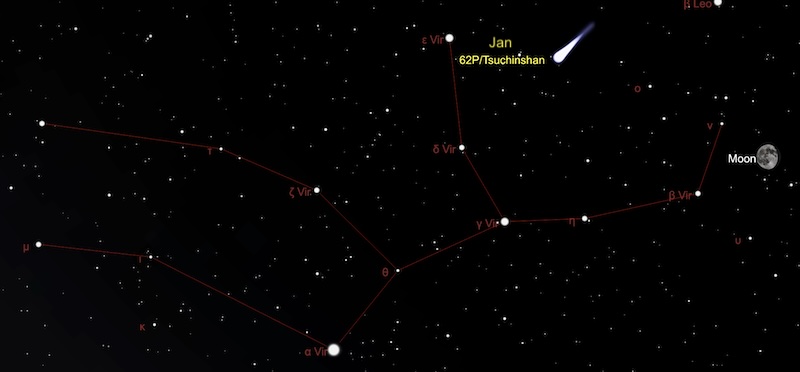
Comet C/2021 S3 PANSTARRSS
C/2021 S3 PANSTARRSS was one of the discoveries of the automated search program Pan-STARRS (Panoramic Survey Telescope and Rapid Response System, on Mount Haleakala in Hawaii). And S3 means it was the third comet discovery or recovery in the second half of September. By the way, it approached us from the south, in a vast and steeply inclined orbit (eccentricity given as 1.0002, inclination 58.5 degrees).
So, in contrast to 62P, it is running fainter than the prediction. It will cross the ecliptic plane northward on February 7, 2024, and pass through perihelion (closest to the sun, 1.32 AU, not far outside Earth’s orbit) on February 14. Then, around February 28, it should be at its brightest, about magnitude seven. Afterward, it’ll cross the celestial equator northward on March 4 and be nearest to Earth (1.29 AU) on March 14. Later, by the end of May it’ll be around magnitude 10. Finally, in August, when it’s at opposition (2.5 AU away from us) and far north in the sky, it’ll probably be a dim magnitude 12.
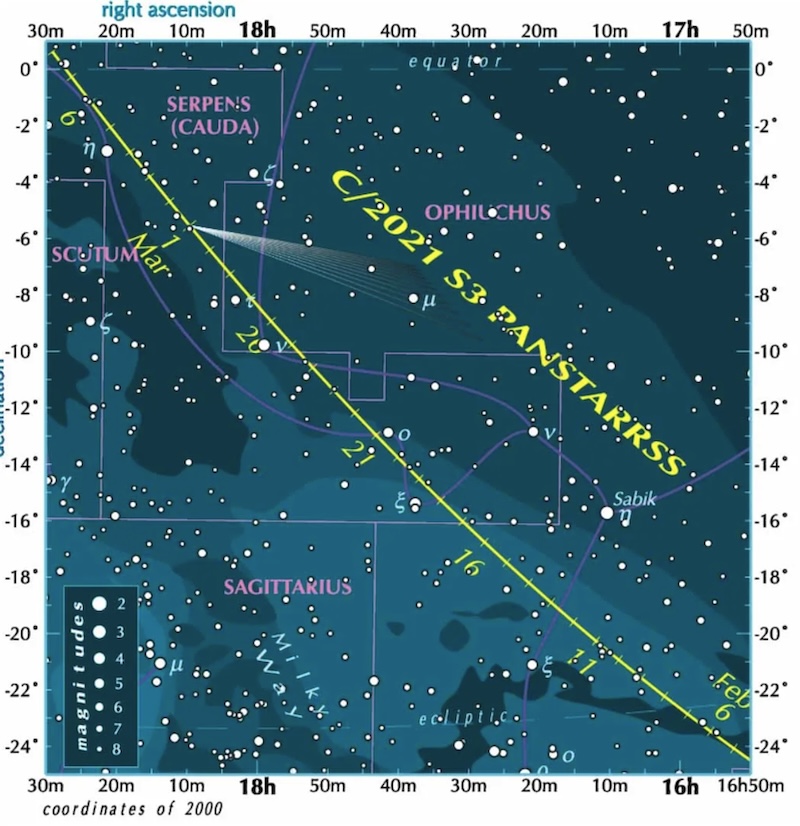
Comet 12P/Pons-Brooks
Comet 12P/Pons-Brooks is a periodic comet (a comet that has an orbit around the sun less than 200 years) discovered by Jean-Louis Pons in 1812 and then recovered by William Robert Brooks in 1883. It orbits the sun every 71 years. At perihelion – or its closest approach to the sun – it will be about 0.78 astronomical units (AU) from the sun. Its aphelion – or its furthest point from the sun – is about 17.2 AU from the sun.
In 2024 Comet 12P/Pons-Brooks is predicted to become bright enough to see with the unaided eye. Coincidentally, it’ll be closest to the sun about two weeks after the total solar eclipse on April 8 2024. So there is a chance observers may be able to see the comet during totality.
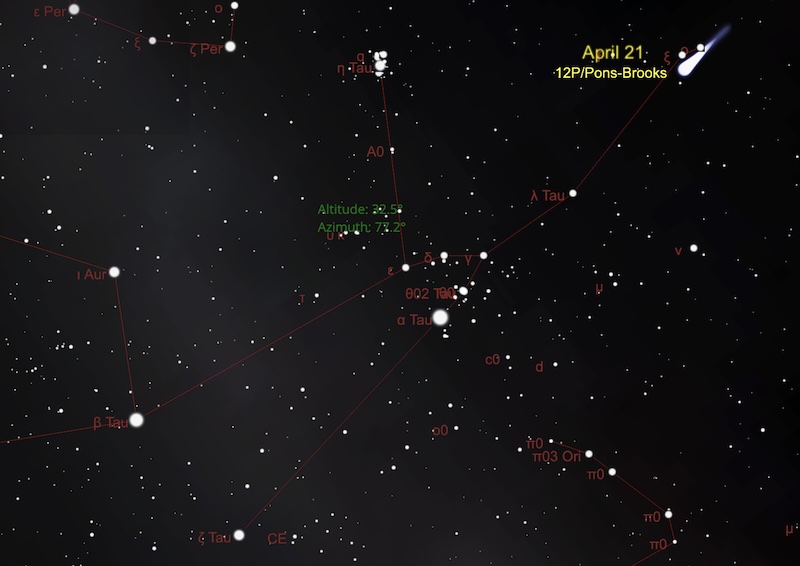
Comet 13P/Olbers
13P/Olbers is a periodic comet with an orbital period of 69 years. The comet was last seen in 1956 and its next perihelion (closest point to the sun) is on June 30, 2024. It’ll be 1.18 AU from the sun and is expected to be shining at around magnitude 7.5.
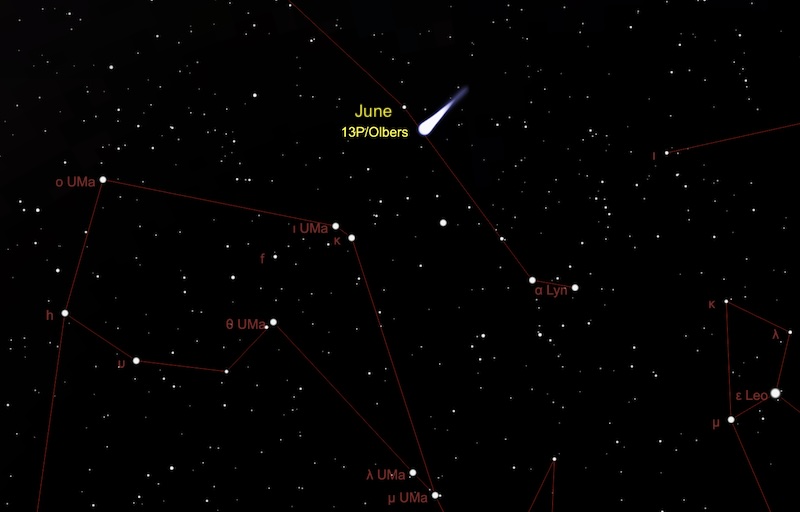
One of the brightest comets in 2024?
And, last but not least, we may have a bright comet in October 2024. Indeed, we are long overdue for a beautiful comet with a wispy comet tail stretching across our evening sky. In October 2024, especially around October 14 through 24, C/2023 A3 (Tsuchinshan-ATLAS) could be bright in the early evening sky. With ten months to go, all looks good for a great showing.
The comet will make its closest approach to the sun perihelion on September 28, 2024. At that point, some estimates are suggesting it might be around magnitude 0.7. That brightness rivals some of the brightest stars in the sky (though, for comets, the brightness is diffuse, not in a single point). Stay tuned!
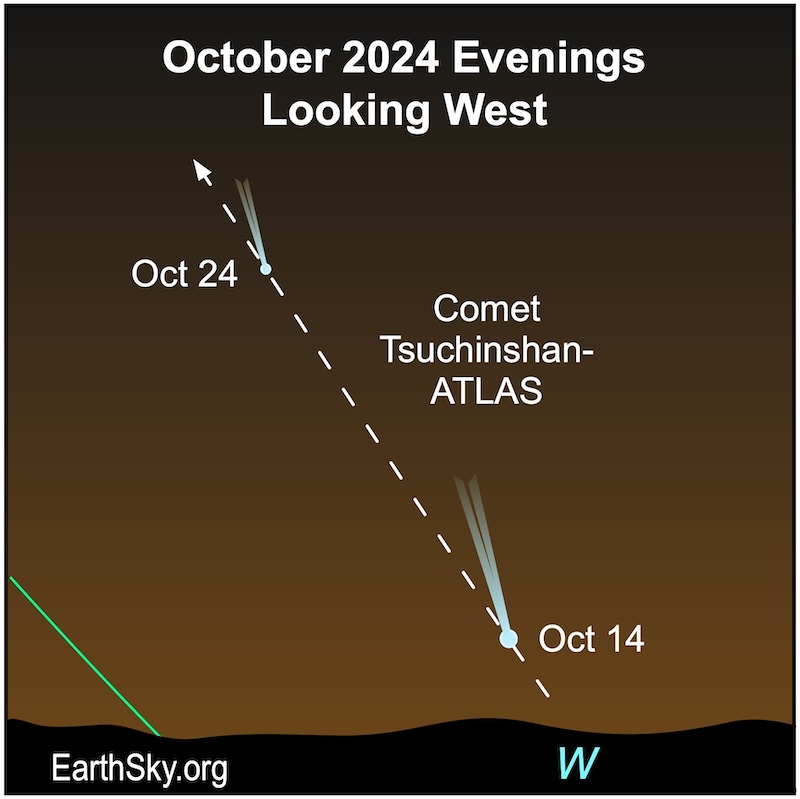
Note from Guy Ottewell
The reason “hairy stars” have been absent from the last few Guy Ottewell’s Astronomical Calendars is because it was difficult to find information far enough in advance about comets likely to be observable.
I used a list of orbital elements for comets provided by the Minor Planet Center and ran calculations for the whole year to find which of them should become observable. The only criterion I’ve used is brightness (astronomically expressed as magnitude).
However, other factors can affect observability: elongation (angular distance from the sun) and declination (how far north or south in the map of the sky).
Bottom line: Here are predictions from Guy Ottewell for the observable comets in 2024. C/2023 A3 Tsuchinshan-ATLAS may be a bright comet in October 2024.











